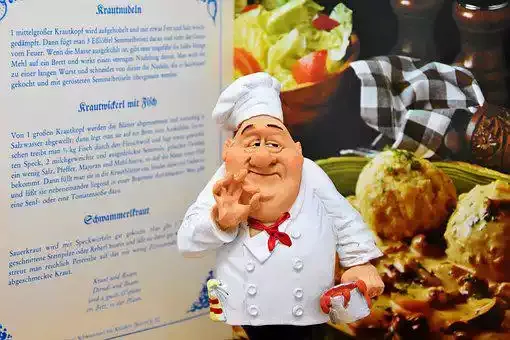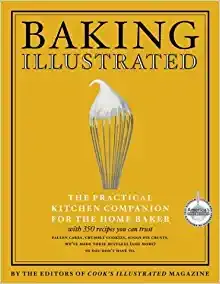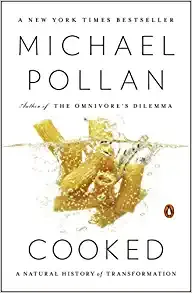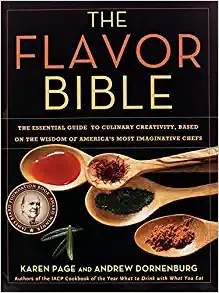In the case that thousands of recipes can be found on the Internet and various food apps, I also buy recipe books one by one. In the final analysis, it is because of laziness. So in the end I fell into the arms of the original recipe book.
There are a lot of recipes that I have tried in the past two years, both borrowed and bought, but there are not many that stay with me in the end.
In addition to being really practical, each of the leftovers has irreplaceable characteristics for me.
I also made a solicitation with my friends in the editorial department and finally selected the following 15 books, which I highly recommend to everyone.
15 Best Books to Learn Cooking Techniques
I have heard people say what a delicious dish is: when you first eat it, it should be a faint taste that makes people indistinguishable, and then feel it with your nose, tongue, and throat, and use your own strength to explore. 'Delicious'.
I have heard of really delicious things, and even after eating, the wonderful aftertaste will always remain. Not only in cooking, but also in work, life, and relationships, the benefits of aftertaste are worthy of attention.
Don't be greedy' Just look at the moment, but keep 'getting better in mind. I want to be someone who cherishes the aftertaste.
Today, I would like to recommend the 15 best cooking techniques books to make it easy for you to be a beginner. Food books are all home dishes, light and delicious, let's eat healthy together.
1. Salt, Fat, Acid, Heat by Samin Nosrat
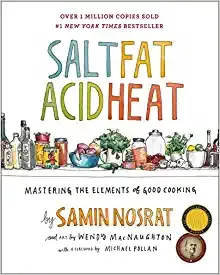
On October 12, Netflix launched its first documentary about cooking, Salt Fat Acid Heat. Its content direction comes from the book of the same name and is hosted by Samin Nosrat, the author of the book.
Published in April 2017, "Salt, Fat, Acid, Heat" was a New York Times bestseller that year and was rated as "a professional guide on how to use accurate techniques to cook good ingredients."
"Salt, Fat, Acid, Heat" also won the James Beard Award for Best Cookbook, an important award in the culinary world, and one of the awards is often used as a reference for choosing cookbooks.
Author Samin Nosrat is a writer and chef. She lives in Berkeley, USA, and has been a professional chef since 2000.
In "Salt, Fat, Acid, Heat", she simplified her cooking experience over the years, and explained how to cook food in the four simple cooking elements of "salt, fat, acid, and heat".
Her basic point is that these four basic culinary elements can make or break a dish. Learning to use them not only makes you a good cook, it actually makes you a super good cook.
The same goes for the documentary "Salt, Fat, Acid, Heat". It's only four episodes in all, and it's both a cooking documentary and a travel documentary.
Host Samin Nosrat travels to the common man's kitchen in Italy, the islands of southern Japan, hot Mexico, and the Chez Panisse restaurant in Berkeley, where she works.
Here she reveals her culinary principles, showing how to incorporate these elements into cooking.
Matching Samin Nosrat's culinary principles, the hosting and shooting style of the documentary "Salt, Fat, Acid, Heat" is relatively unpretentious.
Specifically, Samin Nosrat has a lot of real reactions when hosting. Chopping onions was so spicy that you wrinkled your face, eating spaghetti and making noises, and the rice balls that you squeezed may not be in the perfect shape that is usually seen in the camera...
"Washington Post" described that this documentary looks like Samin Nosrat's life is moving because it's imperfect.
However, this style is not loved by everyone. After the documentary "Salt, Fat, Acid, Heat" was broadcast, some viewers also thought that the host's style was not pleasing, and the presentation of the video might not be as good as that of the book. In the documentary, the producer's discussion of various elements was a little bit to the point.
2. The Joy of Cooking by Irma S. Rombauer
The Joy of Cooking grows with the times-it has a full roster of American and foreign dishes such as strudel, zabaglione, rijsttafel, and couscous, among many others.
All the classic terms found on menus, such as Provençale, bonne femme, meuniére, and Florentine are not merely defined but fully explained so that readers can easily concoct the dish in their own homes.
In this classic edition, readers learn:
- Exactly what simmering, blanching, roasting, and braising does
- In what amounts herbs, spices, and seasonings should be added to recipes
- How to present food correctly
- How to prepare ingredients with classic tools and techniques
- How to safely preserve the results of your canning and freezing
With more than 4,500 recipes and 1,000 easy-to-follow illustrations, The Joy of Cooking is a must for every American kitchen.
This book is known as one of the oldest popular classic cookbooks in modern America. It has a history of nearly eighty years since the first edition in the 1930s and incorporates the cooking wisdom of many famous American chefs from World War II to the present.
A good cookbook not only has a very interesting recipe for the menu, but the most important thing is to tell a story. Stories, whether in the fields of news, novels, design, or drama, are the most fascinating elements. A good recipe book also tells stories. It should tell us about people’s lives and tell us the diet of certain people in a certain period of history.
It is necessary to reveal the opinions of different social classes and tell us that different social classes have different tastes in food, and it is best to show people's wisdom and prejudice. Interesting eating is a whole process, from the quirks of intellectuals to hedonism for pleasure, from culture to science, and finally good writing.
3. The Food Lab: Better Home Cooking Through Science by J. Kenji López-Alt

Probably the best recipe book I've ever read. Even if you don't read a large paragraph of chemical, physical, and thermodynamic principles, you can make delicious food by following the recipe.
But after taking the time to study, you can hopefully get rid of the shackles of recipes and develop your own. There is a big chapter dedicated to fast-cooking food (the first time I saw it in such a high-end book), most of which are done in 10-30 minutes, there is no reason not to cook by yourself!
There are two regrets about this book for me. One is that the whole book focuses on American Food, but Kenji says on his website ( http://www.kenjilopezalt.com/ ) that the second book will "incorporate techniques and ingredients from around the world", so I'm looking forward to it!
The second is that there is nothing related to baking. Kenji said in the foreword that he prefers savory food and is not a baker.
The book teaches how incorporating simple techniques and ingredients from around the world can make your home cooking both more delicious and more efficient. These days in the kitchen we have access to this vast toolset of techniques and tools, so why don't we use them?
This book aims to answer that question in the most delicious way possible. If the first book was about American food and how to cook these big project dishes, the second book is more about how I cook at home EVERY DAY. Not just when I’m entertaining.”
4. Small Victories by Julia Turshen

This cookbook of more than 400 simple cooking recipes and variations from Julia Turshen, writer, go-to recipe developer, and co-author for best-selling cookbooks such as Gwyneth Paltrow's It's All Good, and Dana Cowin's Mastering My Mistakes in the Kitchen, and author of her cookbooks Now & Again and Feed the Resistance.
The process of truly great home cooking ideas is demystified via more than a hundred lessons called out as "small victories" in the funny, encouraging headnotes; these are lessons learned by Julia through a lifetime of cooking thousands of meals.
This beautifully curated, deeply personal collection emphasizes bold-flavored, honest food for breakfast, lunch, dinner, and dessert. More than 160 mouth-watering photographs from acclaimed photographers Gentl + Hyers provide beautiful instruction and inspiration, and a gingham spine elevates this entertaining and essential kitchen resource into a covetable gift cookbook for home cooks.
- Features high-quality photos of recipes to follow while cooking
- Recipes crafted by the author to be both easy to make and follow
Readers of Feed The Resistance, Damn Delicious, and Sneaky Chef will enjoy the simplicity and deliciousness of all recipes featured in this book.
This collection of recipes makes for an ideal:
- Home Cooking Book
- Healthy Recipes Cookbook
- Technique Cookbook
- Cookbook for Family Recipes
5. The New Vegetarian Cooking for Everyone by Deborah Madison

The tenth-anniversary edition of this landmark cookbook, with more than 325,000 copies in print, includes a new introduction from Deborah Madison, America’s leading authority on vegetarian cooking.
What Julia Child is to French cooking, Deborah Madison is to vegetarian cooking—a demystifier and definitive guide to the subject. After her many years as a teacher and writer, she realized that there was no comprehensive primer for vegetarian cooking, no single book that taught vegetarians basic cooking techniques, how to combine ingredients, and how to present vegetarian dishes with style.
Vegetarian Cooking for Everyone teaches readers how to build flavor into vegetable dishes, how to develop vegetable stocks, and how to choose, care for, and cook the many vegetables available to cooks today.
Vegetarian Cooking for Everyone is in every way Deborah Madison’s magnum opus, featuring 1,400 recipes suitable for committed vegetarians, vegans (in most cases), and everyone else who loves good food.
For nonvegetarians, the recipes can be served alongside meat, fish, or fowl and incorporated into a truly contemporary style of eating that emphasizes vegetables and fruits for health and well-being.
Vegetarian Cooking for Everyone is the most comprehensive vegetarian cookbook ever published. The recipes, which range from appetizers to desserts, are colorful and imaginative as well as familiar and comforting.
Madison introduces readers to innovative main course salads; warm and cold soups; vegetable braises and cobblers; golden-crusted gratins; Italian favorites like pasta, polenta, pizza, and risotto; savory tarts and galettes; grilled sandwiches and quesadillas; and creative dishes using grains and heirloom beans.
At the heart of the book is the A-to-Z vegetable chapter, which describes the unique personalities of readily available vegetables, the sauces and seasonings that best complement them, and the simplest ways to prepare them.
“Becoming a Cook” teaches cooking basics, from holding a knife to planning a menu, and “Foundations of Flavor” discusses how to use sauces, herbs, spices, oils, and vinegar to add flavor and character to meatless dishes.
In each chapter, the recipes range from those suitable for everyday dining to dishes for special occasions. And through it all, Madison presents a philosophy of cooking that is both practical and inspiring.
Despite its focus on meatless cooking, Vegetarian Cooking for Everyone is not just for vegetarians—it's for everyone interested in learning how to cook vegetables creatively, healthfully, and passionately.
The recipes are remarkably straightforward, using easy-to-find ingredients in inspiring combinations. Some are simple, others more complex, but all are written with an eye toward the seasonality of produce.
Madison's joyful and free-spirited approach to cooking will send you into the kitchen with confidence and enthusiasm. Whether you are a kitchen novice or an experienced cook, this wonderful cookbook has something for everyone.
6. How to Cook Everything by Mark Bittman
Here's the breakthrough one-stop cooking reference for today's generation of cooks! Nationally known cooking authority Mark Bittman shows you how to prepare great food for all occasions using simple techniques, fresh ingredients, and basic kitchen equipment.
Just as important, How to Cook Everything takes a relaxed, straightforward approach to cooking, so you can enjoy yourself in the kitchen and still achieve outstanding results.
7. Baking Illustrated by the Editors of Cook’s Illustrated
GET IT ON BOOKSHOP.ORG
The practical kitchen companion for the home baker with 350 recipes you can trust. Drawing from more than 10 years of baking experience and exhaustive equipment and ingredient testing Baking Illustrated is packed with over 500 pages of sweet and savory recipes including bread, pizza, cookies, cakes, pies, and tarts. There are home classics, contemporary favorites, and European baked goods.
8. Simple Cake by Odette Williams
Everyone has a favorite style of cake, whether it's citrusy and fresh or chocolatey and indulgent. All of these recipes and more are within your reach in Simple Cake, a love letter from Brooklyn apron and bakeware designer Odette Williams to her favorite treat.
With easy recipes and inventive decorating ideas, Williams gives you recipes for 10 base cakes, 15 toppings, and endless decorating ideas to yield a treat—such as Milk & Honey Cake, Coconut Cake, Summer Berry Pavlova, and Chocolatey Chocolate Cake—for any occasion.
Williams also addresses the fundamentals for getting cakes just right, with foolproof recipes that can be cranked out whenever the urge strikes. Gorgeous photography, along with Williams's warm and heartfelt writing, elevates this book into something truly special.
9. Vietnamese Food Any Day by Andrea Nguyen
Drawing on decades of experience, as well as the cooking hacks her mom adopted after fleeing from Vietnam to America, award-winning author Andrea Nguyen shows you how to use easy-to-find ingredients to create true Vietnamese flavors at home—fast.
With Nguyen as your guide, there’s no need to take a trip to a specialty grocer for favorites such as banh mi, rice paper rolls, and pho, as well as recipes for Honey-Glazed Pork Riblets, Chile Garlic Chicken Wings, Vibrant Turmeric Coconut Rice, and No-Churn Vietnamese Coffee Ice Cream.
Nguyen’s tips and tricks for creating Vietnamese food from ingredients at national supermarkets are indispensable, liberating home cooks and making everyday cooking easier.
10. Barefoot Contessa Family Style: Easy Ideas and Recipes That Make Everyone Feel Like Family by Ina Garten

Ina Garten, who shared her gift for casual entertaining in the bestselling Barefoot Contessa Cookbook and Barefoot Contessa Parties!, is back with her most enticing recipes yet—a collection of her favorite dishes for everyday cooking.
In Barefoot Contessa Family Style, Ina explains that sharing our lives and tables with those we love is too essential to be saved just for special occasions—and it’s easy to do if you know how to cook irresistible meals with a minimum of fuss.
For Ina, the best way to make guests feel at home is to serve them food that’s as unpretentious as it is delicious. So in her new book, she’s collected the recipes that please her friends and family most—dishes like East Hampton Clam Chowder, Parmesan Roasted Asparagus, and Linguine with Shrimp Scampi.
It’s the kind of fresh, accessible food that’s meant to be passed around the table in big bowls or platters and enjoyed with warm conversation and laughter.
In Ina’s hands, tried-and-true dishes are even more delicious than you remember them: Her arugula salad is bright with the flavors of lemon and Parmesan, the Oven-Fried Chicken is crispy without excess fat, and her Deep-Dish Apple Pie has the perfect balance of fruit and spice.
Barefoot Contessa Family Style also includes enticing recipes that are memorable and distinctive, like Lobster Cobb Salad, Tequila Lime Chicken, and Saffron Risotto with Butternut Squash.
With vivid photographs of Ina cooking and serving food in her beautiful Hamptons home, as well as menu suggestions, practical wisdom on what to do when disaster strikes in the kitchen, and tips on creating an inviting ambiance with music, Barefoot Contessa Family Style is the must-have guide to the joy of everyday entertaining.
11. Homestyle Cooking From Scratch
Homemade recipes are budget-friendly and I know what I am feeding my family. Prepared foods are loaded with sodium and many ingredients that I do not want to feed my family.
Many recipes I have used for years but it is nice to have them all in one handy reference book. This is an excellent cookbook and reference source for beginning cooks, new brides, and for anyone who loves cooking from scratch. I love cooking for my family and friends.
The information and recipes in this book are from decades of cooking experience. Everyone knows my freezer and pantry are always full. Family and friends know they are always welcome at my table. Single family members and friends tend to drop by for a quick meal or dessert.
Having a full pantry and freezer makes it easy to make quick meals and share memories with them. If you are looking for gourmet recipes or fancy ingredients, this is not the book for you.
This is homemade and homestyle cooking at its best. Stocking a freezer or pantry can be overwhelming in the beginning. It is also expensive to buy everything needed at one time.
Stock your freezer and pantry a few items at a time. When I first started stocking my pantry, I spent an extra $5 each week on items for the pantry. Start slowly and steadily increasing your pantry items.
If you are making rice, make double the amount and freeze the extra. If you are browning ground beef, cook a double batch and freeze the extra meat. Start slowly and steadily increasing your freezer meals based on your freezer space, time, and money.
12. The Third Plate by Dan Barber
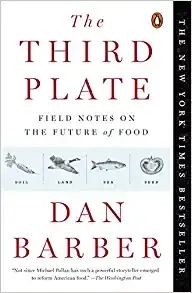
I never considered myself a foodie. Still, after finishing the book, I am convinced that foodies or not could save the planet and make a better earth, only if thru mindful and conscientious eating.
The remarkable side of the book is not only about the damage done to our agriculture and aquaculture by industrialized farming (monoculture) and fishing (overfishing) but also about the vision of our future's food.
To make our agriculture/aquaculture sustainable, we, as the farmer/fisherman/breeder, chef, and consumer, should change our conventional thinking and practice of conquering and taming nature to work in concert with nature.
Only by admitting and complying with nature, we can restore the lost variety, flavor, nutrition, and beloved culture. The author is a great storyteller.
The book is readable, knowledgeable, mind-refreshing, funny, moving, and touching. Can you picture the following scenes:
- How about the feeling of "cooking naked in the kitchen"?
- How can you imagine the world-known ocean conservationist, who is fighting all his life to protect bluefin tuna, served a plate of tuna?
- How a seed breeder bring his mom back to her memory by restoring the lost rice variety?
- How foie gras not from force-feeding?
- How a seed breeder bring his mom back to her memory by restoring the lost rice variety?
- How foie gras not from force-feeding?
Lastly, I can assure you that when put the book down, you surely enjoyed and learned quite a bit.
13. On Food and Cooking: The Science and Lore of the Kitchen by Harold McGee
When it comes to cooking, I usually learn and imitate other people's practices. Although I can summarize some general rules, I am more detailed about why I do it and how to cook better.
I don't know much about it. This thick book provides answers to many questions and provides a detailed introduction to the history, production, various cooking techniques, and corresponding molecular changes of each type of ingredient.
The author is very knowledgeable and has a certain understanding of the food of various countries. Some chapters start out poetically, like the egg chapter. It is very worth having, and it is also suitable as a reference book and the like.
14. Cooked: A Natural History of Transformation by Michael Pollan
This book records the author's systematic learning of traditional cooking from a first-person perspective.
According to the four elements of fire, water, wind, and earth in nature, it is divided into four parts, and four traditional cooking methods of barbecue, stew, bake, and fermentation are written respectively.
Basically, each part is divided into the first half and the second half, two parts, with a clear rhythm.
The first half is still in the style of food culture books, writing about cooking itself, there are many interesting food culture explorations, and occasionally some philosophies are interspersed, and the poetic sentences that make people after a long time come one after another. In the
In the second half, the writing style is transformed into a social documentary category, criticizing the human food culture and health that the modern food processing industry is gradually destroying, which is thought-provoking and thought-provoking.
After reading it, I have a more fundamental understanding of cooking. Slow work not only produces fine work but also delicious food.
Don't abandon the best cooking methods created by our ancestors and honed through thousands of years of repeated experiments because of laziness.
Although modern food technology processing speeds up the process of food from ingredients to mouth, it can bring superfluous effects.
Although I was eager to try it when I was reading the book, I was defeated by reality after reading it.
15. The Flavor Bible by Karen Page and Andrew Domenburg
Great cooking goes beyond following a recipe--it's knowing how to season ingredients to coax the greatest possible flavor from them. Drawing on dozens of leading chefs' combined experience in top restaurants across the country, Karen Page and Andrew Dornenburg present the definitive guide to creating "deliciousness" in any dish.
Thousands of ingredient entries, organized alphabetically and cross-referenced, provide a treasure trove of spectacular flavor combinations. Readers will learn to work more intuitively and effectively with ingredients; experiment with temperature and texture; excite the nose and palate with herbs, spices, and other seasonings; and balance the sensual, emotional, and spiritual elements of an extraordinary meal.
Seasoned with tips, anecdotes, and signature dishes from America's most imaginative chefs, THE FLAVOR BIBLE is an essential reference for every kitchen.

